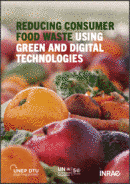Skills and Knowledge for Reducing Consumer Food Waste
There are at least two aspects to skills and knowledge: research to generate knowledge on food waste; and providing knowledge to consumers to help reduce waste.
Research
Research
Understanding waste levels at consumer level is important for planning and decision making. Information on what and how much is discarded can help to open a dialogue with consumers regarding how they can best take care of their food. As a way to address this, Norway's ForMat Project – a food waste prevention initiative - developed a consumer food waste table which shows the extent and composition of the food, including fish, a typical Norwegian throws away each year. This was accomplished through annual consumer surveys of 1000 respondents, and which focused on food waste, and demographics (age, gender, place of residence, education, etc.). One survey dealt with food discard habits and the other with behaviour and attitudes related to food waste. Consumers reported on their behaviours and attitudes related to food, and a waste sample analysis was performed by researchers in a random sample of households.
Education
Education
Educating consumers is a key way to creating food waste awareness. Producing and distributing brochures/pamphlets is one strategy to explain how consumers can take care of food. Information can be given to waste companies, local authorities, schools, universities and colleges to distribute at events. Food and other festivals, farmers days can be good events at which to distribute information. Learning tools such as quizzes can also be used to help get important messages across.
Avoiding Food Waste
Avoiding Food Waste
A large share of food wasted by the consumer is avoidable: Consumers throw away food that is in fact still consumable, but that does not meet expectations in terms of how the food looks or because the best-before date is approaching or has passed.
Best practices and strategies to reduce food waste include:
- Measure how much food is thrown away
- Plan meals in advance and stick to a shopping list to save money, time and eat healthier food.
- Only buy what will be used
- Maximize the shelf life of produce good food storage practice. Be aware of date labels (e.g. expiration dates)
- Be mindful of old ingredients and leftovers to use up. Move food that's likely to spoil soon to the front of a shelf or designated "eat now" area. Practice First In First Out (FIFO) for stock rotation.
- Freeze fresh foods and leftovers to preserve to eat later
- Use all the scraps from the products bought
- Composting to reduce waste after meals
- Donate unused food to a local food rescue organization
Key Publications
This initiative aims to raise awareness for reducing food waste and helps consumers take action by doing easy everyday things in the home, ultimately wasting less, saving money, and benefiting the environment. | |
The US Environmental Protection Agency: Too Good To Waste Campaign The United States EPA and Department of Agriculture launched a national food loss and waste goal. The organizations partner with public and private sector to cut food loss and waste in half by 2030. | |
University of Nebraska: 14 Ways Consumers Can Reduce Food Waste Recommendations on how consumers can reduce food waste are included. |
More Resources
More Resources
31 October 2023














